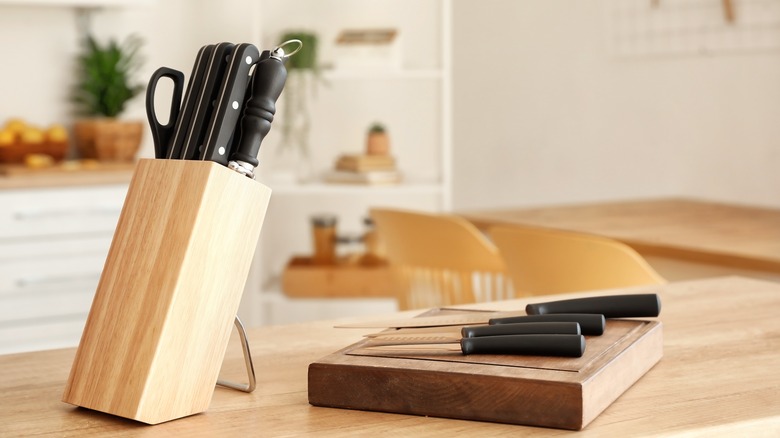One Of The Tensest Moments In Martha Stewart's Doc Gave Us A Practical Cooking Tip
On Wednesday, October 30, 2024, Netflix released R.J. Cutler's documentary, "Martha," which takes viewers on a journey through many years of Martha Stewart's storied past. In the documentary's second half, it shows Martha Stewart prepping for an Easter Sunday dinner in 2004, a scene captured by the film crew that she welcomed into her home. With a menu of hard-boiled eggs, smoked salmon, lamb, fish, and more, all intended to feed 16-20 guests, Stewart had a lot of work on her hands and naturally enlisted the help of assistants in the kitchen, one of whom she seemingly became frustrated with for using the wrong knife.
Stewart approached the assistant and asked them which knife they were using to cut oranges. When the assistant showed Stewart a paring knife, the celebrity chef admonished them, stating, "Well, isn't that a stupid knife?" She then went on to question, "Why? Why would you use a little knife to cut a big orange? Do you know how fast a big knife cuts?" She then grabbed what appeared to be a chef's knife and stated, "You use a big knife to cut oranges, okay?"
A chef's knife is, indeed, the right choice for the job because its longer blade makes it more efficient, allowing you to cut straight through the orange. Paring knives, which tend to have 3- to 4-inch blades, are better suited for smaller fruits and veggies or for segmenting citrus fruits into wedges.
Knives you need and how to care for them
While there are plenty of different kinds of knives out there, some would say that many home cooks have too many of them. In fact, you really only need three knives to tackle most kitchen tasks: a paring knife, a chef's knife, and a knife with a serrated blade.
Not only are paring knives ideal for cutting relatively small fruits and veggies, but they're practical for peeling the skin off of produce, too. You can also use them for precise tasks like deveining shrimp, mincing garlic, coring apples, or hulling strawberries. Meanwhile, chef's knives are significantly larger and have a plethora of purposes, from chopping up nuts, fruits, and vegetables to slicing meat. Finally, serrated knives are your best friend when you need to slice bread, cut through frozen foods, or slice tomatoes without squishing them.
Once you have your kitchen stocked with high-quality versions of these three knives, you'll need to take good care of them so they remain sharp and safe. Always wash them by hand rather than in the dishwasher, dry them directly after washing, and avoid scraping them on a cutting board. Plus, when storing them, keep them away from other kitchen tools that could scratch and dull them by using a knife block or a magnetic holder. You can even wrap your knives in newspaper to keep them at their best.


